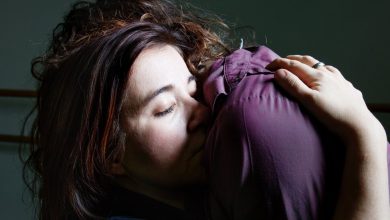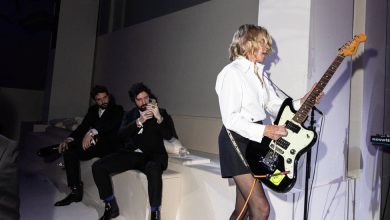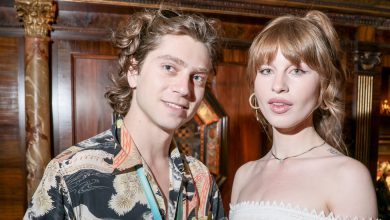Joan Semmel Takes an Unflinching View of Her Own Body

JOAN SEMMEL WAS defiant from the start, not the sort to go with the flow even as a young girl. “I was never very good at taking direction at what to do,” she observes wryly when I visit her one early fall day in the capacious yet cozy Spring Street loft in SoHo where she has lived and worked since 1970. “My mother used to say she didn’t know where I came from, that they must have mixed up babies in the hospital.”
This attitude might account for her taking on the primal and provocative subject matter that would make her reputation: ourselves, naked. In the early 1970s, Semmel started making large-scale oil paintings of nude partners having sex, their bodies rendered in vivid Neo-expressionist colors like red, purple, yellow and an acid or bluish green that gives off a spectral glow. The perspective in the works is subjective, close-up and deliberately skewed, requiring a concentrated effort on the part of the viewer to compose the limbs, buttocks, breasts, vaginas and penises into recognizable images of men and women. These paintings would eventually be followed by ones documenting Semmel’s own nude body as it’s aged over the decades.
The almost pornographic yet matter-of-fact graphicness that marks Semmel’s work might be taken for granted today (the work of Lisa Yuskavage, Marilyn Minter and Angela Dufresne comes to mind), but was jolting when Semmel was starting out. And even now, her paintings retain their ability to shock or put off viewers, including women. When I showed a few of Semmel’s self-portraits to a friend of mine, her main response was one of disgust, and images of Semmel’s work have been censored by Instagram for their nudity. The artist’sprovocativeintentions are unrelated to sensationalism in and of itself, though; rather, they derive from her wish to go up against historical messages, whether coming from the art world or pop culture, about women’s sexual passivity and perceived value as seductive lure to men. “Women are essentially chattel in so much of the history of Western art,” Semmel observes. “That’s what I rebelled against.”
Semmel, who turned 89 on Oct. 19, has finally been given her first retrospective, “Skin in the Game,” which covers more than six decades and will stay up through April 3 at the Pennsylvania Academy of Fine Arts (PAFA) in Philadelphia. In addition to her realist nudes, it includes early abstract paintings, drawings and collages. AsSemmel attests, she has always had a “back and forth” with abstraction, aiming to use abstract and realist elements together. She adds that she never wanted to conform to any particular style and has never considered herself a realist. “I found those distinctions spurious,” she declares.
One could ask why it took so long for a painter of Semmel’s daring, skill and influence to be accorded this tribute, which comes after decades of her having been put in the descriptive box of “feminist artist.” Semmel is indeed a passionate feminist, but she would like for her work to be considered “on its own terms,” she says, adding that, “feminist art should be mainstream — not off in the corner, a footnote in history.” Then again, one could also ask why Louise Bourgeois and Alice Neel were in their 70s before either of them wasgiven a retrospective. (The sculptor Louise Nevelson, by contrast, snubbed feminism and aligned herself with male art critics like Hilton Kramer and Robert Hughes, neither of whom had any use for women’s clamor about inequality. Which might explain why she had her first major museum retrospective, at the Whitney in 1967, when she was “only” 67).
To really answer the question, one would have to address the lack of regard given to women painters and sculptors from the beginning, whether the mode of the moment was, say, Impressionism or Abstract Expressionism or Photo Realism. This is something with which critics, curators and artists including Semmel have long grappled, especially since the advent of second-wave feminism. Whatever answer one comes up with, though, is likely to have something to do with age-old attitudes about gender and the nature of creative genius.
Although representations of nude female figures had been and continued to be a crucial part of the Western arttradition in the ’70s, they were mostly done from a male point of view, and frequently had a voyeuristic and titillating slant. One has only to think of Édouard Manet’s “Olympia” (1863) or Gustave Courbet’s infamous “Origin of the World” (1866) (once owned, tellingly or not, by the psychoanalyst Jacques Lacan), which features a daringly cropped close-up of the genitals of a naked woman lying on a bed with her legs spread. In the classicist Mary Beard’s documentary “Shock of the Nude” (2020), the historian sums up the dominance of the male gaze in her musings on the Medici Venus, a life-size Hellenistic marble sculpture depicting Aphrodite, the Greek goddess of love: “I’m never quite sure … whether I’m with those guys peering up the statue’s bum,” she says, “or whether it’s my bum they’re peering up. It’s those difficult questions about yourself that are the real shock of the nude.”
The institutional exclusion of women artists and the collective understanding of the concept of greatness, a label typically applied to white male artists, are taken up, famously, in Linda Nochlin’s 1971 essay, “Why Have There Been No Great Women Artists?” The piece gets itself into a quandary of sorts, first questioning the legitimacy of the inquiry and then backpedaling over its own quibbles to ascribe this supposed absence to a lack of education and exposure. When I allude to this essay, Semmel’s response is crisp: “It’s time we let go of that article. Great women artists are never celebrated. They rise and then they’re written out.”

On the floor, leaning against a larger canvas titled “Center Elbow” (2020), is a highly colored and as yet untitled fleshy nude. On the wall is “Spaced Out” (2020), a painting of a reclining figure with red-tinged hands and limbs.
Credit…Emiliano Granado
SEMMEL WEARS HER grayish-white hair girlishly long and still bears traces of her youthful beauty. Her keen blue eyes seem to miss nothing, and she has an energy about her that would put women several decades her junior to shame, despite her having recently taken a fall and wounded her leg. Notwithstanding my protests that I am going on to a late dinner after my visit, she insists on serving me supper — scallops, sweet potatoes and asparagus — navigating cautiously in the small kitchen. This gracious hostess side of her is unexpected and, coming from a woman with such fierce drive and a hard-won sense of independence, quite touching.
In the carpeted studio with 14-foot-high ceilings, which is separated from the living room area by an eight-foot-wide wooden door, several plants sit on the ledge of large windows overlooking Spring Street, and there is an old-school desk with a computer, printer and piles of paper on it. Semmel uses two glass-topped rolling carts to hold her cans of brushes and squeezed tubes of oil paint. A finished canvas, a nude self-portrait, leans against the paint-splattered easternwall.
Ever since the 1980s, Semmel’s project has been to depict her own body — prone, crouched or twisted and frequently truncated — with drooping breasts and rolls of flesh and all, as it moves ever further from the idealized youth of traditional female portraiture. In the studio are also other smaller examples of these works, which feature swaths of hot and cool hues. Sometimes Semmel applies the paint in thin, fluid expanses, and at other times in thick layers, and the canvasses have a textured, tactile quality, as if the nude figures they depict invite touch. In all the paintings Semmel wears a large turquoise ring that she describes as an identity marker. The ring also has a technical purpose in that it introduces, says Semmel, “another kind of color and surface against the softness of the flesh.”
Semmel, nee Alperstein, grew up in the Bronx; her mother was an immigrant from Eastern Europe, and her father was an American who had been brought up by an Orthodox Jewish family after his mother died. He owned a dry-cleaning business, and Semmel’s mother was a fastidious housewife who was on her knees every morning taking a sponge to the floors. Semmel, who had a younger brother, was a sickly child with constant mastoiditis. She spent a lot of time indoors, drawing with crayons and pastels and copying comics. She also liked to read, despite the absence of books at home (Charles Dickens’s “David Copperfield,” 1849, was one of the few) and would embark on weekly walks to the library and bring back “reams of books.” In junior high she joined art clubs, and one of her teachers told her mother that she was talented and should apply to Manhattan’s High School for Music & Art. When I ask her where she thinks she got her aesthetic sensibility from, she raises her arms, suggesting that such matters are impenetrable mysteries. “The compulsion drives us,” she says. “It’s hard to know where compulsion comes from. If I knew what drove me, I wouldn’t have been driven.”
At Music & Art Semmel was exposed to a world beyond the one she had known until then. “It was an intellectual environment very different from the background I had come from,” she recalls. “I saw real art and slides, and went to museums for the first time.” When she decided to go next to Cooper Union, instead of City College, she realized she had “made the choice to be an artist.” (One of her high school teachers was disappointed: “You have this logical mind,” he said. “It will be wasted.”) Once there, she took courses in the flat graphic style called 2-D design made popular by the painter Stuart Davis, as well as in Ashcan School painting and early Abstract Expressionism. “There wasn’t much in the way of realism,” she recalls. “No Renaissance. The mantra was ‘The picture plane is flat.’”
She married Harold Semmel, at the age of 19, in 1952, the same year she graduated from Cooper Union. After that, she worked as a model in the garment district for five months. She’d been painting on the side, but stopped when she moved back in with her parents while her husband, an engineer, was posted to North Africa during the Korean War, because, as she notes, still incredulous all these years later, “women couldn’t live alone.” The couple’s daughter, Patricia, was born in 1955, when theywere living the bourgeois life in a garden apartment in Bayside, Queens. Semmel came down with tuberculosis a year and a half later and was hospitalized for six months, during which time a piece of one of her lungs was taken out. She recalls that during that time she read “a book a day” and knew, she says, that “I was going to go back to painting. I realized that the life I had was centered around my family, and I needed something for myself.”
In 1963, after Semmel had gotten a BFA from Pratt Institute, her husband’s firm relocated him to Madrid. “We went for a year,” she says, “and I stayed for seven and a half.” She liked how far money went in Spain — the family lived in a duplex apartment with a pool on the roof — and the liberating experience of being a nonnative. In a revealing essay titled “A Necessary Elaboration,” which appears in the catalog that accompanied her 2015 show, “Joan Semmel: Across Five Decades,” at Alexander Gray Associates in New York, the gallery she has been with for a decade, she writes, “As an American artist and a foreigner in Madrid, I was not expected to conform. They considered all foreign women totally immoral, so it didn’t really matter.” She enjoyed, too, the “heady mix” of people from “all strata of life,” including“foreign correspondents … business expatriates and any number of characters out of F. Scott Fitzgerald.” Semmel notes that “I emerged a different person.” She had a son, Andrew, in 1965 and, after her husband left for South America, she remained in Madrid, where she exhibited her abstract paintings. (“I think they were very strong,” she asserts.) In 1970, when her son was of school age, she returned with the children to New York and filed for divorce, which she had been unable to do in Spain, where it was illegal.
SEMMEL’S LIFE AS an artist really took off after she settled into her loft. It was then that she started working figuratively, a bold move ata time when the style was considered if not dead, then at least passé. She also discovered feminism, which led to her involvement with other women artists, including Joyce Kozloff, Judith Bernstein, May Stevens, Miriam Schapiro, Anita Steckel, Carolee Schneemann, Juanita McNeely, Nancy Spero, Emma Amos and Hannah Wilke, who all wanted to change the culture with their work. (I tell Semmel this listof names is too long to include in this piece in full, but she is adamant about my keeping every one.) “There was great excitement in New York City at that time,” she says. “There was a constant interchange that lasted through the down years.”
In 1973, Semmel joined Steckel’s nascent Fight Censorship (FC) group, whose agenda focused on the wider acceptance of sexually explicit artworks by women. Shortly thereafter, Semmel began to create her “Sex Paintings” and “Erotic Series,” which consist of large-scale depictions of naked heterosexual couples performingsex acts. With the “Erotic Series” she moved from working from drawings to black-and-white photographs she’d taken of the couples, mostly friends (in some of Semmel’s works, she’s included an image of herself wielding the camera), but continued to employ nonrepresentational color as a primary element. “At that time, the use of photography by a painter was considered not quite legitimate,” she writes in “A Necessary Elaboration.” But, she goes on, “I appropriated the modeled form and smooth surface of the closely cropped photograph into my paintings, which tended to push the image out from the picture plane into the viewer’s space. … This served as a distancing device defining the object as art, and separating it from the realm of pornography.”
I ask her why she chose sexuality as her subject. “I found still-lifes and landscapesso boring,” she answers. “I identified with the female body. I felt very strongly that women needed to be able to express their own sexual desires rather than follow the Hollywood concept of the chivalric tradition, in which Sleeping Beauty is aroused to passion by the handsome prince. I was a woman at the height of my sexual powers and didn’t want to be ashamed of it.” Her work owes, then, very much to the feminist conviction that the personal is political. “The imagery that invades our consciousness,” she says, “and constructs our sense of who we are and how we should be — ‘mother and child,’ ‘pretty woman,’ ‘heroic male’ — ideas about sexuality without shame, vulnerability in women and the aged, have all been the content of my work as I have lived them through my own experience.”
Semmel moved to using her own body as a subject partly, she explains, “to stay away from the objectification issue. I was also very interested in perceiving your body through your own eyes.” In an interview she did with the writer and professor Richard Meyer in 2007, she said that she was trying “to find an erotic language to which women could respond, one which did not reiterate the male power positions and prevalent fetishizations.” Semmel wasn’t alone in this: Philip Perlstein was creating precise, dispassionate nude portraits, while Betty Tompkins was producing her unabashed black-and-white paintings of couples engaged in coitus, and predating all of them was the pioneering Suzanne Valadon, who painted one of the first full-length female nude self-portraits in “Adam and Eve” (1909). But in insisting on the primacy and validity of the female nude in its own right, not as an object to be judged by male spectators, Semmel helped start an artistic revolution that would eventually influence painters such as Jenny Saville to take on the raw topography of female fleshiness, andeven corpulence, with fearless abandon. “In contrast to the nudes of art history,” the art critic Deborah Solomon tells me, “Semmel’s figures are purged of idealization and offer us a view of femaleness that allows for awkward poses and bovine thighs. She paints skin that is clearly inhabited by real women — women who are variously shown sitting or lying down, touching, relaxing, intent on their own comfort and satisfaction rather than self-display.”
Although Semmel’s “Sex Paintings” would receive favorable reviews, she couldn’t find a gallery that would actually show them, and, in 1952, had to rent her own exhibition space at 141 Prince Street. She was also seen as flouting some of the tenets of second-wave feminism. In a piece by Alison M. Gingeras published in 2015 in Art News, the curator makes the retrospective argument that because black sheep feminist artists (as she dubs them) like Semmel “embraced a sex-positive attitude in their work,” and explored “the extreme edges of feminist politics and sexualized iconography,” they were “systematically excluded from important exhibitions and catalogs devoted to women’s art.”
When I raise this point with her, she replies that she wasn’t swayed by the movement’s assumptions, despite being lead to believe, as she puts it, “that a woman’s body was colonized territory, that there was no way of using it without objectifying women.” She goes on to say that women were critical of her “because they felt if you played with the female nude, it would end up in the male playground.” I remark, half-humorously, that Semmel happens to have had (and still has) what would be considered a conventionally attractive body, prompting her to shoot back: “I didn’t think I had a good body. None of us ever feel we have a great body. It’s never just right.”
SEMMEL’S RETROSPECTIVE AT the PAFA is a thoughtfully curated (by Jodi Throckmorton), beautifully hung presentation of an entirely ravishing collection of her work. The 64 pieces on view include early Ab-Ex paintings; two figure studies for “Sex Paintings” that make use of quick, sinuous lines reminiscent of erotic drawings by Henri Matisse; and a tender yet gimlet-eyed depiction of a women’s changing room, part of Semmel’s “Locker-Room” series (1988-91), that shows a group of nude figures: one is sitting at a counter, another is in the shower, one is peering at herself in the mirror and one is anxiously checking her weight on a balance beam scale. Viewers also encounter three slightly eerie paintings of mannequins from the late ’90s; several of Semmel’s overlay paintings, in which newer line drawings of hers are superimposed upon earlier images, imparting a sense of dynamism and dissolution; and an ambitious triptych from 1977 called “Mythologies and Me,” for which Semmel painted a parody of a Playboy centerfold and a parody of a Willem de Kooning portrait of a woman and placed them on either side of a self-portrait. The effect is almost discordant, but also riveting, like a cacophony of voices each demanding to be heard. The focus of the exhibit is on Semmel’s iconic nudes, including the most recent iterations, which utilize techniques of blurring and outlining and doubling, sometimes on the artist’s face.
I suppose one might call Semmel a painter’s painter, as some have, and the show makes her love affair with paint itself, and with color, abundantly clear, except that this designation makes her sound insulated from the larger world. In truth, one comes away with an impression of a woman using her painterly and intellectual skills with unbounded determination to capture both her inner life and the life of the culture in which she resides; even within a single painting, one can see Semmel thinking her way through intense conflict and the possibility of resolution. “The canvas becomes the tender skin of fragile thoughts,” she once wrote. Put another way, beneath her invocations of female flesh is a vital presence who engages us in her ongoing struggle to define herself — and, by extension, us.
“Skin in the Game” is something of a revelation, and should put to an end any doubts about Semmel’s significance as an artist, not merely a feminist artist. As I walk around the exhibit, something the poet Adrienne Rich once said keeps dancing in my head: “A thinking woman sleeps with monsters.” It is a measure of Semmel’s enormous talent and intelligence that she has taken the monsters that besiege us and made of them something compelling and luminous and beautiful.




